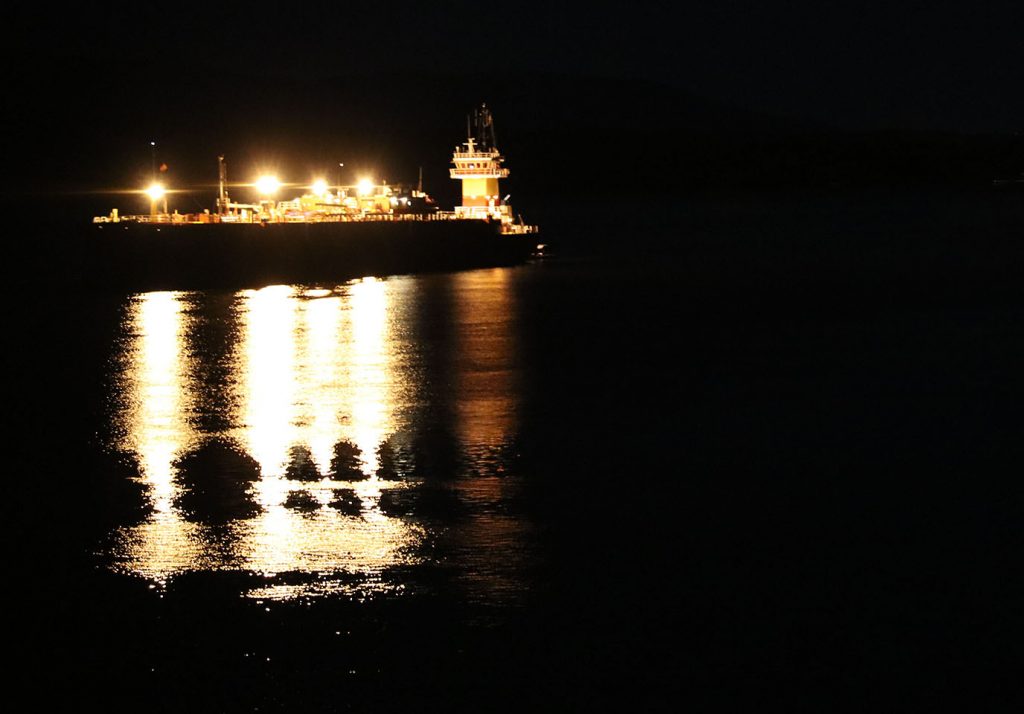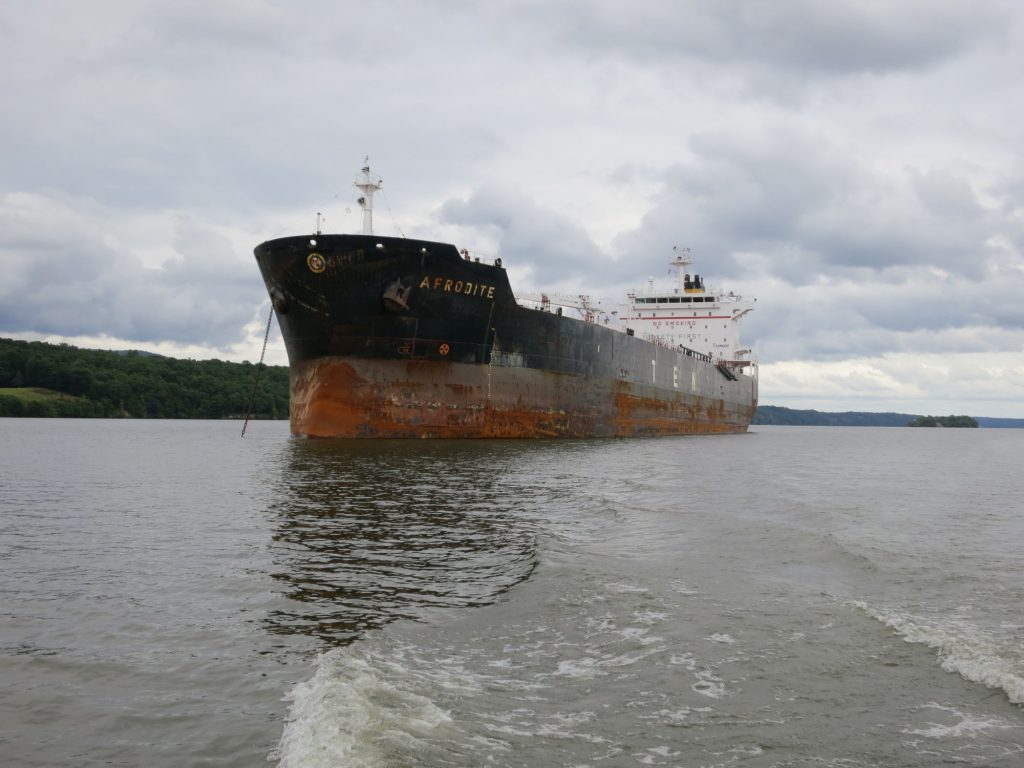ANCHORS AWAY
DOMESTIC OIL BOOM MANIFESTS INDUSTRIAL VISIONS ALONG THE HUDSON
Story by Jon Bowermaster
Film by Chris Rahm & Devin Pickering
hile we were fighting tooth and nail to ban hydraulic fracturing in New York State, many didn’t notice the influx of large barges traversing the river. But if you are a resident of Kingston, Newburgh, or Yonkers, it’s hard to ignore the 600 foot vessels parked along the riverfront.
The Hudson River has served as a marine highway since it’s discovery by Henry Hudson, connecting Albany, the “Port of Export”, to New York City, the economic capital of world. It has served as a corridor for transporting goods from the interior to the northeastern coast. Fur, timber, food, and tobacco were some of the first cargo to traverse the river. Today, crude oil from the Bakken Shale in North Dakota has begun making its way along the channel by barge. A new proposal to increase the number of anchorages in the Hudson suggests that more barges will follow suit, meaning more risk for the river.
Interactive map of proposed Anchorage locations – 43 overall berths divided amongst 10 different lots that span from Yonkers all the way north to Kingston.
There are currently seven federally designated anchorages along the Hudson. The proposal from the American Waterways Operators, the Hudson River Port Pilots Association, and the Maritime Association of the Port of NY/NJ Tug and Barge Committee asks the US Coast Guard to designate 10 different locations as anchoring grounds, supporting 43 commercial barges in total. It’s no surprise that this has become a heated debate among environmental advocates and mariners.
Trade will increase on the Hudson River significantly over the next few years with the lifting of the ban on American Crude exports for foreign trade and federally designated anchorages are key to supporting trade.”
– Industry Proposal to Coast Guard
Commercial Marine Operators are requesting the federal recognition of these anchorages, some of which they are already utilizing, for the sake of safety and environmental protection. Because Kingston is a halfway point between New York and Albany, the operators are asking to anchor there when visibility is low, and resume the 8 hour trip to Albany during the daylight. While this may seem like a reasonable appeal, it doesn’t address the issue of what is being carried in those barges and why.
The proposal states, “Trade will increase on the Hudson River significantly over the next few years with the lifting of the ban on American Crude exports for foreign trade and federally designated anchorages are key to supporting trade.”
If safety were the true concern, a proposal to have designated emergency anchorages for severe weather would suffice.

The real issue that residents in the Hudson River Valley are concerned with is having hazardous oil being transported along a vital ecosystem for the residents of the state. This oil is not heating oil or gasoline, substances which have been carried up and down the river for decades. American Bakken Crude Oil is highly toxic, volatile, and contains combustible gases. While noise and light pollution are a problem, this is not a mere NIMBY argument. The real risk is pollution and habitat destruction.
Erik Kiviat, Executive Director of Hudsonia, has studied the ecology of the Hudson River Valley for 45 years. He questions if the anchorage proposal is a “devils in the details issue.”
“Anytime you take something big and move it from one place to another there are going to be impacts. They could be trivial, serious, or somewhere in between but there will be an effect.”
The people along the Hudson are fighting hard to not let our industrial past sneak back up to further damage the river.
Kiviat expressed concern about potential impacts resulting from collision, wakes, leaks and spills, and risks associated with the exact location of the berths. He questions whether there is a higher risk of accidents when barges are maneuvering in and out of the proposed berths.
Another question that he and other researchers have raised is the effect of the barges wake on submerged vegetation and fish nurseries. Today, ships follow a clear channel down the middle of the Hudson, but if anchorages are established in areas such as the Kingston Flats, an important fish spawning area for the endangered Shortnose Sturgeon, the generated wake will cause more damage to these fragile habitats. An accidental spill would be devastating.
Tug and barge anchored on the Hudson River between Kingston and Rhinecliff. In addition to impacting property values and quality of life, the specter of a toxic oil spill hangs over communities from Manhattan to Albany.
The people along the Hudson are fighting hard to not let our industrial past sneak back up to further damage the river. While the Hudson is one of the nation’s largest superfund sites, it is also an American Heritage River. We’ve seen the positive economic and environmental impacts that have come out of revitalizing communities, promoting tourism and recreation, and conservation efforts.
For small scale boaters, the anchorages are a safety concern. Barges already outnumber the amount of ships on the river 10 times over. As the proposal suggests, we can expect a higher number of barges on the river with open trade laws.
But groups and individuals are working hard to put a stop to the proposal being passed. Riverkeeper, Scenic Hudson and Clearwater are just a few of the advocates urging the Coast Guard to say no to these anchorages.
A resident commented to Riverkeeper stating, “The 31 community boat clubs of the Hudson River Boat & Yacht Club Association and our 3,000 boating families greatly appreciates Riverkeeper looking closely at the facts. These anchorages are wrong for the river, will only benefit a few, take away public access and increase safety and environmental concerns for all mariners. We would not allow oil tanks to be built on public lands and we should not allow oil to be stored on the river.”

The Hudson’s long history of environmentalism won’t allow this issue to be taken lightly. Our history shaped the National Environmental Policy Act of 1969, requiring all major projects to have an environmental impact study to respond the questions that are left unanswered. In the city of Croton, a recent hearing about the anchorages allowed residents to express their concern for the river becoming a fossil fuel “highway”. However, what really stunned and angered the attendees was the lack of representation from the Coast Guard. While the Coast Guard intends to hold a hearing in the spring, they leave questions unanswered before the deadline for commenting on the proposal, December 6th. Hopefully, they will show face in the small window of time in which they can provide some answers.



